-
Paper Information
- Previous Paper
- Paper Submission
-
Journal Information
- About This Journal
- Editorial Board
- Current Issue
- Archive
- Author Guidelines
- Contact Us
Resources and Environment
p-ISSN: 2163-2618 e-ISSN: 2163-2634
2016; 6(6): 112-116
doi:10.5923/j.re.20160606.02

The Pattern of Landfill Leachates Pollution in Tidal Waste Land: A Case Study in TPA Basirih, Banjarmasin, Indonesia
Irfa’i
Environmental Health Department of Health Polytechnic Banjarmasin, Ministry of Health, Indonesia
Correspondence to: Irfa’i, Environmental Health Department of Health Polytechnic Banjarmasin, Ministry of Health, Indonesia.
| Email: |  |
Copyright © 2016 Scientific & Academic Publishing. All Rights Reserved.
This work is licensed under the Creative Commons Attribution International License (CC BY).
http://creativecommons.org/licenses/by/4.0/

The main issue in the perspective expectation of tidal TPA (landfill) is about the big potential in polluting the environment. One of the pollutants which caused by the TPA is leachates. The pattern of the pollution dissemination which caused by the TPA is spread evenly/cluster. Pollutans start to spread from TPA at the distance of 0 M up to 200 M without showing that there is a reduction of pollution concentration.The even dissemination of the pollution concentration occurred both in water or soil media. This condition is caused by the factor that the location of this TPA is in tidal area and the soil condition with high porosity of saturated water. The pollutants concentration of the river which caused by leachates, is relatively spread evenly on the observation area either when it’s tide or subsided. This condition is caused by the tide or subsided flow which continuosly happens twice a day which will make the level of water and pollutants mixing is spread evenly.
Keywords: Pattern, Dissemination, Leachates, Tidal TPA
Cite this paper: Irfa’i, The Pattern of Landfill Leachates Pollution in Tidal Waste Land: A Case Study in TPA Basirih, Banjarmasin, Indonesia, Resources and Environment, Vol. 6 No. 6, 2016, pp. 112-116. doi: 10.5923/j.re.20160606.02.
Article Outline
1. Introduction
- Leachate generated from landfill, is an important source of environmental pollution around the landfill. The increase in municipal waste Banjarmasin reached 1019 m3 per day and is likely to increase from year to year will increase the production of leachate and the more potential to pollute the environment. The presence of leachate from the landfill has a high risk of contaminating water and soil around the landfill [1]. Leachate contains dissolved organic material, inorganic compounds and metals [2]. The dump has been identified as one of the major threats to water resources and land [3].The quantity of leachate at the landfill is determined by the intensity of the rain, the effective area of the landfill, evaporation, infiltration / soil porosity and moisture content of litter. As for the quality of the leachate composition determined by the type of waste, the amount of garbage, the amount of water that dissolves landfill waste and operational systems. The purpose of this study to determine the pattern of spread of landfill leachate to the surrounding environment. The pattern of spread of leachate is required in order to attempt leachate management, including the collection, transmission, treatment and discharge of leachate into the environment.Production of leachate coming from the liquid contents in the trash because of the decomposition process is also involved rain water into the garbage and litter decomposition dissolving material that accumulates at the bottom of the landfill and seeping through the ground [4]. Contamination occurs due to the continuous leachate seeping into the environment from time to time regardless of the environmental consequences [5]. Landfill conditions in the tidal area further increased the potential for leachate contamination of the environment. The existence of leachate at the landfill must be managed and processed so that it does not cause environmental pollution. To perform the necessary processing of accurate data, a pattern of contamination, quantities and quality of landfill leachate on tidal land.The tidal condition of the environtment affected the leachates amount and dissemination around the TPA environtment. Tidal water caused the soil to be water-rich. The existence of tidal condition also effected the underground water flow which tend to be up and down / unstable which caused the leachates dissemination to be evenly spread. The dissemination of leachates could spread on the TPA surrounding area by cluster.The pattern of leachates dissemination in the TPA area is influenced by the flow direction of ground water, ground water velocity, soil porosity as well as the quality and quantity of leachates pollutant [6]. The surface water flow also has a role on the TPA leachates dissemination. Dissemination through the surface water flow is influenced by the TPA infrasctruture which is not sufficient enough. The dike leakage and leachates leakage is caused by an unappropriate dike. The leachates run-off water is due to the high intensity of rain which could not be accommodated by the Installation of Leachates Management, it is also as the reason of leachates dissemination around the environtmet. The tidal area condition also affected the dissemination pattern of the pollutant.
2. Research Methods
- The method used in this study is a survey method. The survey was conducted to measure the distribution of leachate at the landfill area. Measuring the quality of leachate in an area with a certain distance in the area of tide and low tide area. The survey was also conducted on the condition of landfill environment, especially factors tidal surface water, soil type, rainfall and potential flooding. The frequency of sampling done 3 times for the dry season and the third time for the rainy season.The collected data was in the form of primary and secondary data. Primary data were obtained from a direct interview with the TPA manager, leachates water quality and quantity measurement and an interview with other relevant instantion or agency. In the implementation of primary data collection, it was in the form of leachates quality measurement on the surrounding area. The leachates quality measurement was preceded by creating a well for water sampling. The number of samples taken as many as 72 samples. Measuring the quality of leachate preceded by wells for water sampling. Determination of sample points is done linearly from the source (TPA) with a distance of 0 meters, 50 meters, 100 meters, 150 meters and 200 meters towards the ups and downs direction. While the river water sampling conducted at the point of the flow of the upstream and downstream at the point on the river around the landfill. The parameters of leachates pollutants which observed on the water in this research was Biological Oxygen Demand (BOD5), Chemical Oxygen Demand (COD), Total Disolved Solid (TDS), Iron (Fe) and NH3N. While the parameters of leachates pollutants which observed on the ground in this research was P2O5, SO4, dissolved Iron (Fe) and N-HN4. The observation towards the leachates dissemination was conducted for a year. Primary and secondary data was analyzed and formulated to determine the leachates quality in the surrounding area of TPA Banjarmasin.
3. Results and Discussion
- The dissemination of leachates pollutant on the water and soil around TPA.The leachates dissemination pattern of the tidal TPA was observed on water in a tide and subsided area next to the TPA location. On a tide area, the TDS dissemination was decreased, it was 1500 mg/liter at first and then it decreased until 506 mg/liter at the distance of 200 m. While in other parameters, the leachates dissemination pattern was occurred evenly and less likely to be decreased at the distance up to 200 m. BOD dissemination on a tide area was evenly spread in the range of 38.55 mg/liter to 59,57 mg/liter as well as the COD dissemination in the range of 314,21mg/liter to 718.38 mg/liter. Fe dissemination was also evenly spread in the range of 4.3 mg/liter to 22.03 mg/liter and NH3N in the range of 13.89 mg/liter to 42.72 mg/liter. Whereas the pH condition on a tide area was in the range of 7.43 to 7.93. For further details about the pollutants dissemination on a tide area, it can be seen on figure 1.
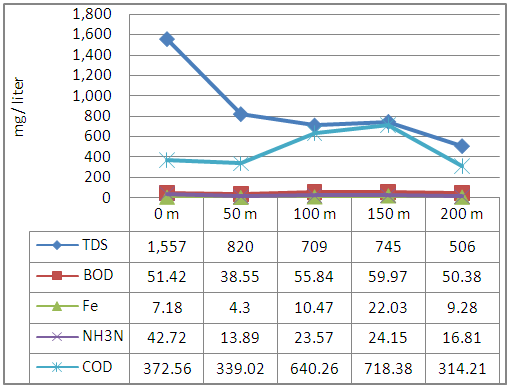 | Figure 1. The Patt ern of Leachates Dissemination in Water on a Tide Area |
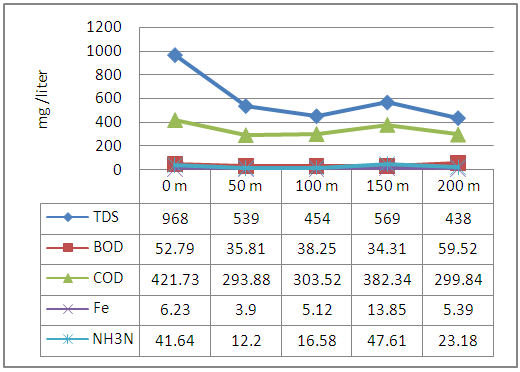 | Figure 2. The Pattern of Leachates Dissemination in Water on a Subsided Area |
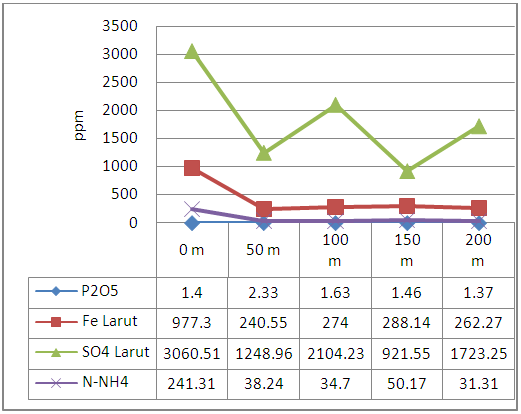 | Figure 3. The Pattern of Leachates Dissemination in Soil on a Tide Area |
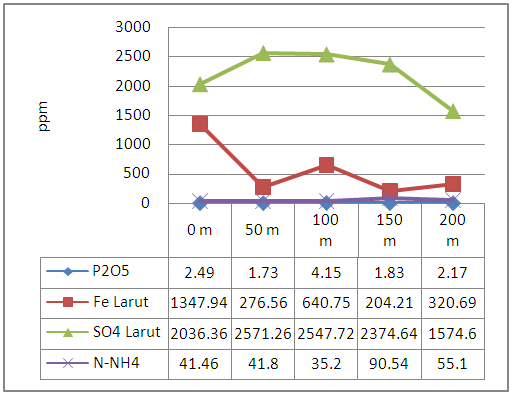 | Figure 4. The Pattern of Leachates Dissemination in Soil on a Subsided Area |
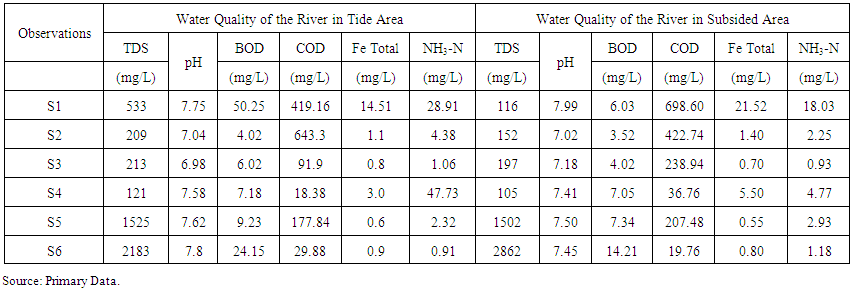 | Table 1. The water quality comparison of the river around tidal TPA |
4. Conclusions and Suggestion
- ConclusionsTheir rapid groundwater flow in the area of tide and ebb implications on the speed of diffusion of pollutants leachate. This condition will spread the leachate kelingkungan quickly. The content of pollutants which spread from TPA is in the distance of 0 m up to 200 m and it dissseminate evenly without showing the reduction of pollutants concentration. The even distribution of pollutant concentration occurred both in water and solid media. It is because of the TPA location which located in a tidal area and which soil with high porosity of saturated water at Peat soils. The concentraion of pollutants in the river which caused by leachates is relatively even either in a tide or subsided area.It is because of the existence of tide and subsided flow which happened continuously twice a day that caused the even mixing of water and pollutants. Implications of speed of deployment around the landfill leachate on tidal land requires landfill operators to isolate the leachate to not seep out of the landfill.SuggestionObserve and examine the influence of leachates pollutants in TPA towards fishes, plants and the socio-economic community on the subsequent research.
Thank You Note
- Thanks to Mr. Prof Suyadiand Mr. DR Bagyo Yanuwiadi as a Promoter dan Co-promoter. We also present a thank you for the Director of Poltekkes because of the funding support in the implementation of learning assignment as well as the other parties which we can not mentioned one by one.
 Abstract
Abstract Reference
Reference Full-Text PDF
Full-Text PDF Full-text HTML
Full-text HTML